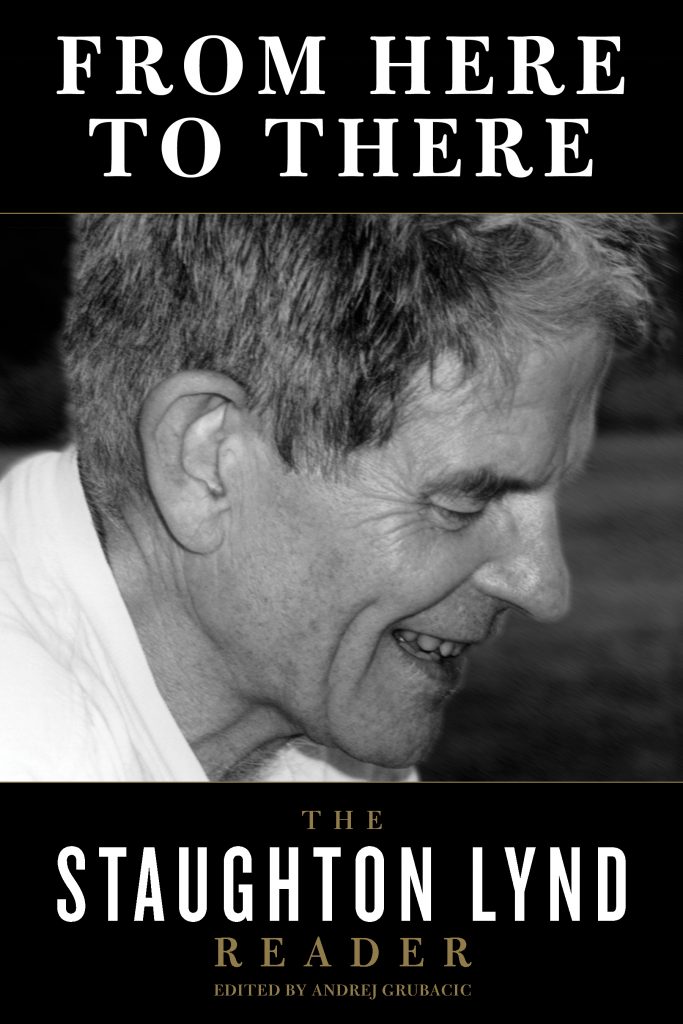by Joe Berry
Labor Studies Journal 36, no. 4, pgs. 545-560
Some labor educators might pass by this book as just another tribute collection to an old colleague. That would be a big mistake. Like recent collections of Howard Zinn’s work, From Here to There both reminds us of the remarkable time span of Staughton Lynd’s life and activism and documents the growth and insight of an activist academic who became a true organic intellectual, though that was not his origin.
This collection of both previously published and unpublished pieces ranges from the early 1960s to 2009. They reflect the breadth of Lynd’s interests and activities, which here are organized in four sections, “The Sixties,” “History,” “Possibilities,” and “Conclusions.”
“The Sixties” includes contemporary reports, essays, and speeches, some of which were directed to young radicals during the 1960s and some of which were directed to people searching for lessons at a later time. They include pieces on Thoreau, Socialism, SNCC and the Freedom Schools (of which Lynd was the director), participatory democ- racy or self-activity, and the Cold War origins and the purges in labor. “History” ranges from his own views on doing radical history, to stories about committing the crime of “history from the bottom up” (which he correctly credits to Jesse Lemish and Students for a Democratic Society), to the Kennedy assassination and doing guerrilla history in Gary, Indiana.
“Possibilities” encompasses, among others, essays on nonviolence as solidarity, overcoming racism, students and workers, and perhaps most important, E. P. Thompson’s concept of “warrens” of working-class counterorganization, culture, and power in society. Finally, in “Possibilities,” Lynd discusses what his eighty years have taught him about American imperialism, the “repressive tolerance” of U.S. society, the global capitalist crisis, and the sources of solidarity that might end it.
Of particular interest currently to labor educators, union activists, and labor studies scholars is his general perspective, expressed in many pieces, on lateral solidarity, as opposed to hierarchical centralized organization. He is a socialist, even a Marxist of sorts, but he admires a number of anarchist concepts that have gained new credibility among young activists. Connected with this is his discussion, again in a number of sections and in the introduction by Grubacic, of the concept of “accompaniment,” taken from Monsignor Romero of El Salvador, as an expression of the proper form for solidarity to take when exercised by those with more resources and privileges vis-à-vis those with less.
Taken together with his thoughtful comments on the relations of student struggles to those of workers, from the 1950s to the present, we have more than enough reason to look seriously at this old radical’s long-considered observations and judgments. A final reward is his discussion of how activists and radicals should relate to each other, in other words what fraternal and comradely behavior looks like and how we have disregarded it to our serious detriment in the past.
This is one of those books that can be read usefully by educators and, especially in sections, assigned in even the most basic labor-education classes.
This review would not be complete without some mention of Lynd’s large contri- bution directly to labor education. Few books, and the movies based upon them, have been more useful than his and his wife Alice Lynd’s Rank and File. His little Solidarity Unionism: Labor Law for the Rank and Filer (recently revised and reissued) has found its way into thousands of workers’ pockets. Finally, his example of his own “reinven- tion of himself” when blacklisted out of the historical profession and academia should give all of us a bit more courage when we have to decide “how far we can go.”
Back to Staughton Lynd’s Author Page | Back to Andrej Grubacic’s Author Page







